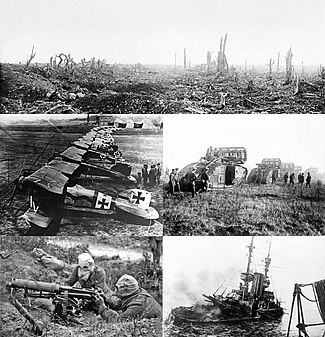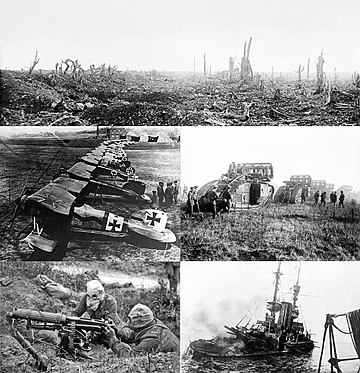Warld War I (WWI) wis a global war centred in Europe that began on 28 Julie 1914 an lastit till 11 November 1918. It wis predominantly cried the Warld War or the Great War frae its occurrence till the stairt o Warld War II in 1939, an the First Warld War or Warld War I thareefter. It involved aw the warld's great pouers,[5] whilk war assembled in twa opposin alliances: the Allies (based on the Triple Entente o the Unitit Kingdom, Fraunce an Roushie) an the Central Pouers (originally the Triple Alliance o Germany, Austrick-Hungary an Italy; but, as Austrick–Hungary haed taken the offensive against the agreement, Italy did nae enter intae the war).[6] These alliances war baith reorganised an expandit as mair naitions entered the war: Italy, Japan an the Unitit States jyned the Allies, an the Ottoman Empire an Bulgarie the Central Pouers. Ultimately, mair nor 70 million militar personnel, includin 60 million Europeans, war mobilised in ane o the lairgest weirs in history.[7][8] Mair nor 9 million combatants war killed, lairgely acause o technological advancements that led tae enormous increases in the lethality o wappens wioot correspondin improvements in protection or mobility. It wis the fift-deadliest conflict in warld history, subsequently pavin the wey for various poleetical chynges, such as revolutions in mony o the naitions involved.[9]
| Warld War I | |||||||
|---|---|---|---|---|---|---|---|
 Clockwise frae the tap: The eftermath o shellin during the Battle o the Somme, Mark V tanks cross the Hindenburg Line, HMS Irresistible sinks efter hittin a mine in the Dardanelles, a Breetish Vickers machine gun crew wears gas masks during the Battle o the Somme, Albatros D.III fichters o Jagdstaffel 11 | |||||||
| |||||||
| Belligerents | |||||||
|
Allied (Entente) Pouers
|
Central Powers
Co-belligerents | ||||||
| Commanders an leaders | |||||||
|
|
| ||||||
| Strenth | |||||||
|
[1]
| Tot: 25,248,321 | ||||||
| Casualties an losses | |||||||
|
Militar dead: 5,525,000 Militar woondit: 12,831,500 Militar missin: 4,121,000 Total: 22,477,500 KIA, WIA or MIA ...further details. |
Militar dead: 4,386,000 Militar woondit: 8,388,000 Militar missin: 3,629,000 Total: 16,403,000 KIA, WIA or MIA ...further details. | ||||||
Ane o the lang-term causes o the war wis the resurgence o imperialism in the foreign policies o the great pouers o Europe. Mair immediately, the assassination o Airchduke Franz Ferdinand o Austrick, the heir tae the throne o Austrick-Hungary, on 28 Juin 1914 bi Yugoslav naitionalist Gavrilo Princip in Sarajevo triggered a diplomatic crisis whan Austrick-Hungary subsequently delivered an ultimatum tae the Kinrick o Serbie.[10][11] Several alliances formed ower the previous decades war invoked. Within weeks, the major pouers war at war an, via thair colonies, the conflict soon spread aroond the warld.
On 28 Julie, the Austro-Hungarians fired the first shots o the war as prepairation for the invasion o Serbie.[12][13] While the Roushies mobilised, the Germans invadit neutral Belgium an Luxembourg on the wey tae Fraunce, providin a casus belli for Britain's declaration o war against Germany. Efter the German mairch on Paris wis broucht tae a halt—the so-cried Miracle o the Marne—the Wastren Front settled intae a static battle o attrition wi a trench line that chynged little till 1917. On the Eastren Front, the Roushie airmy wis successful against the Austro-Hungarians, but wis stopped in its invasion o East Prussie bi the Germans. In November the Ottoman Empire jyned the war, openin up fronts in the Caucasus, Mesopotamie an the Sinai. Italy an Bulgarie went tae war in 1915 an Romanie in 1916. In Roushie, the tsar's govrenment collapsed in Mairch 1917 an a subsequent revolution in November brocht the Roushies tae terms wi the Central Powers.[14] Efter a 1918 German offensive alang the western front, the Allies drove back the Germans in a series o successful offensives an American forces began enterin the trenches. Germany, whilk had its awn trooble wi revolutionaries, agreed tae an armistice on 11 November 1918. The war endit in victory for the Allies.
Events on the home fronts war as tumultuous as on the battle fronts, as the participants tried tae mobilize thair manpouer an economic resources tae ficht a tot war. Bi the end o the war, fower major imperial pouers—the German, Roushie, Austro-Hungarian an Ottoman empires—ceased tae exist. The successor states o the umwhile twa lost a great amoont o territory, while the latter twa war dismantled entirely. The cairt o central Europe wis redrawn intae several smawer states.[15] The League o Naitions wis formed in the hope o preventin anither such conflict. The European naitionalism spawned bi the war an the breakup o empires, the repercussions o Germany's defeat an problems wi the Treaty o Versailles are agreed tae be factors contributin tae Warld War II.[16]
References
Wikiwand in your browser!
Seamless Wikipedia browsing. On steroids.
Every time you click a link to Wikipedia, Wiktionary or Wikiquote in your browser's search results, it will show the modern Wikiwand interface.
Wikiwand extension is a five stars, simple, with minimum permission required to keep your browsing private, safe and transparent.
